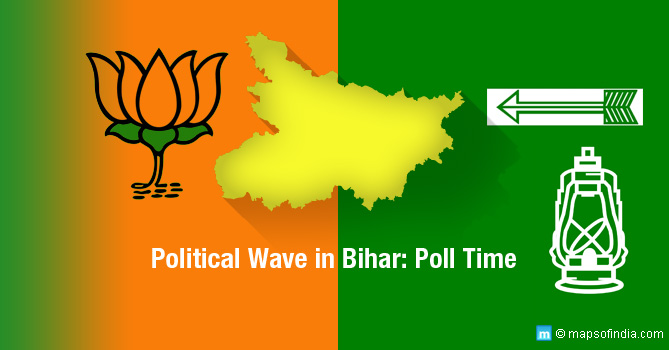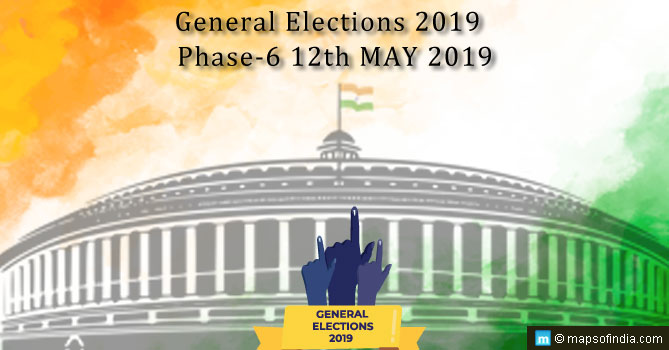Bihar is all set for an encore of the epic battle ‘Mahabharata’ as it lays the ground to play Kurukshetra. The cause, aim and objective of the battle remains the same – the right to rule, only this time the protagonists are different and as earlier, it’s going to be a fight to finish.
As in the original epic, hectic lobbying, promises and alliances borne out of kinship and caste laid out the canvas are defining the protagonists on opposing sides. This time around it is the BJP on one side, with support from Ram Vilas Paswan-led Lok Jan Shakti Party (LJP), Jitan Ram Manjhi-led Hindustan Awami Morcha (HAM) and Upendra Kushwaha’s Rashtriya Lok Samta Party (RLSP), and on the other side is a grand alliance of Nitish Kumar-led Janata Dal (United), Lalu Prasad Yadav-led Rashtriya Janata Dal (RJD) and the Sonia Gandhi-led Congress.
What’s at stake?
Bihar has always been a political pot boiler and this year has been no different. In many ways, the battle has started off even before the war. Political equations that had been carefully calculated and crafted have crumbled with alliance partners walking off over seat sharing. And with the election date about to be announced any day, the political equations remain fragile and tenuous, with each faction trying to seek out its own advantage.
Nitish-Lalu-Congress come together in an unlikely alliance
To see what’s at stake, look no further than Lalu Prasad Yadav. A former Chief Minister and political heavyweight in Bihar has now been reduced to clutching at every straw the wind offers. After his ban that barred him from standing for elections, he was forced to reach out to Mulayam Singh Yadav, the Samajwadi Party supremo, and offer his youngest daughter Raj Lakshmi, in matrimonial alliance to Mulayam Singh’s grandnephew Tej Pratap, a move reminiscent of the old days when rulers used matrimony to neutralise opposition and build alliances. Earlier, Lalu Prasad Yadav had to swallow his ego to reach out to his old rival, Nitish Kumar in a bid to survive and take on a resurgent BJP. Such are the demands of politics.
Nitish Kumar, on his part, is no political novice and no stranger to reworking political alliances based on the need for the day. He came to power riding on support from the BJP after vanquishing deep entrenched Lalu Yadav and his RLD. The victory pitchforked Nitish Kumar as the Chief Minister and he established his credentials on a development platform, as against the much maligned ‘Jungle Raj’ under Lalu Prasad’s long tenure as the CM.
In the run up to the Lok Sabha polls in 2014, Nitish Kumar took a stand against Narendra Modi’s appointment as the Prime Ministerial candidate and this led to his walking out of his well-established alliance with the BJP. The move backfired and the 2014 General elections revealed two outcomes. One, Nitish Kumar and his JD(U) came out considerably weakened and the BJP came out considerably stronger. Taking ownership for the poor performance in the 2014 General Elections, Nitish Kumar stepped down from CM’s post and selected Jitan Manjhi, who represents the Dalit vote bank, as his replacement.
What was supposed to be a docile front man actually found his voice and feet and Jitan Manjhi was soon rebelling against Nitish’s influence in the party. Jitan Manjhi has since switched loyalties and is now fighting on the side of the BJP against his former associates.
The Mulayam – NCP Factor
The ‘Mahagathbandhan’ or ‘Grand Alliance’ was a result of absolute necessity to take on a rising BJP. Political exigency forced Mulayam-Nitish-Lalu-NCP-Congress to come together in a united attempt to stop the BJP making further inroads into the state. Individually, none of them had the strength and therefore came up with this grand plan. But alliances without synergistic ideology rarely last and the same was the case with this ‘Mahagathbandhan’. The fragile alliance was soon tottering with the NCP pulling out on being denied adequate seats. Soon, it was Mulayam’s turn to claim his fair share of seats. With neither Lalu nor Nitish willing to give ground beyond five seats, it was a matter of time before Mulayam Singh walked out of the alliance.
Mulayam could well be the x-factor in this election but is caught between the devil and the deep sea. On one hand, he has tried to distance himself from the Congress by refusing to share the election rally Dias with Sonia Gandhi; on the other hand, he is unable to overtly join the BJP camp, which will result in eroding his Muslim support base. Samajwadi Party has always tried to champion the Muslim cause, which represents a sizeable vote bank in U.P, and with U.P. Assembly elections due in future, he has a tough choice to make. Having taken a stance against the ‘Mahagathbandhan’, SP will be forced to go it alone thereby ruling itself out of the overall equation but can still be a spoiler for both the warring camps.
So what now remains is a weakened Nitish Kumar holding support from a shaky Lalu Prasad and a marginalized Congress, in a fervent hope that the equations will last till the elections. Lalu Prasad has been trying to woo Mulayam and has claimed Mulayam’s outside support but how that translates into votes remains an open question.
BJP-LJP-HAM-RSLP Alliance just about hanging in there
This is going to be Narendra Modi’s battle all the way. He has staked his reputation on line by being the face of the BJP campaign. After the drubbing it received in Delhi, the BJP is desperate to win Bihar. It is this desperation that has made Narendra Modi wear his PM hat when he grandiosely announced in an election rally in Bihar the Rs 1.25 lakh crore special package for the state. This has been promptly denounced by Nitish Kumar as mere re-packaging of old schemes and previous allocations and presenting it as a part of a large dole for the state. The debate on this one continues, as does the fight for supporters.
Amit Shah has been trying to ward off grumblings from his alliance partners on announcing seat sharing formula but has steadfastly refused to do so till now. LJP, RSLP and HAM are all wanting more seats and are unhappy with Amit Shah’s reticence in announcing the seat sharing numbers but neither can do much about it, as on their own, none have the strength to stand up to the BJP and therefore have no choice but to accept whatever the BJP offers. But Bihar politics is as fluid as the flowing waters of the Ganga; it can reach any side at any time and Amit Shah is fully aware of that.
The Amit Shah-Narendra Modi duo is confident of pulling off their winning formula in Bihar, but the ‘Mahagathbandhan’ is leaving no stone unturned to fight back. They have taken a leaf from the tech savvy media campaign managers from the Modi camp by coming out with their own version of social media counters. They have come up with a cartoon version of Narendra Modi as ‘Jumla Babu’, a word taken from Amit Shah’s uttering and turned it around against the BJP camp. ‘Jumla Babu’ is all about Narendra Modi giving false promises and taking the people of Bihar for a ride. The campaign is gaining traction and amusement amongst the people of Bihar.
The Numbers Game still doesn’t quite add up for either side
Caste equations have always played a major role in Bihar politics and this time will be no different. However, this time around, Bihar is very different from the Bihar of 2010, when the last Assembly elections were fought.
In 2010, JD(U) held sway winning 115 seats with alliance partner BJP contributing 91 seats, which gave Nitish Kumar total control of the Assembly with 206 out of a total of 243 seats. But that was then. Today, the JD(U) has split from the BJP and this time has RJD and Congress on its side. But is this good enough?
In 2010, JD(U) contested 141 seats and won 115 seats, while RJD fought 168 seats but could win just 22 seats. This reflects the gap between the strengths of the two parties. The question is – does this gap still hold well? Is JD(U) still good enough to repeat 115 seats or more this time over? Especially with Mulayam taking away some of the Yadav votes away? Lalu Prasad is definitely weaker than in 2010 but with him openly pushing his sons to take over his legacy, will he be able to rope in 22 seats? This time both the parties have decided to contest 100 constituencies each. Both realise that 2015 will be tough to do an encore but is the gamble to go with 100 each good enough? The Congress that won just 4 seats in 2010 will continue to remain on the fringes.
On the other hand, in 2010, the BJP fought 102 seats and won 91. This time, Team Amit Shah is confident of stronger showing and is thus fighting at least 160 seats. Shah is banking on rebels that have switched sides and is confident of his alliance partners bagging the required numbers to enable BJP rule Bihar. It’s a gamble that could go either ways. Narendra Modi’s magic has certainly waned since 2014 and the people of Bihar today are far more educated and aware, thanks to an overactive media complimented by the added influence of social media.
The Three Potential Game Changers
In 2015, traditional equations will be severely tested by three segments that could well act as a spoiler to existing equations. First is the ‘female’ voter, followed by the ‘Mahadalits’ and finally the ‘Muslims’. All three can change equations on voting day and the final results will reveal to what extent.
The traditional demure, illiterate Bihari housewife has made way for a very aware and increasingly assertive of her rights ‘housewife’, which along with a very aware and upwardly mobile female youth that is emerging as a significant vote segment in itself. Earlier, this segment would blindly vote as per ‘instructions’ of her husband or senior male member of the family. No more. Today, this segment makes their decisions based on informed choices, on what she believes will work best for her interests. This could be a big change from 2010.
JD(U) – RJD have traditionally relied on the Yadav community support along with support from Mahadalits and Backward classes that make up around 44% of the voters, and Muslim communities, which represent around 15% of the population. Jitan Manjhi, who represents the Dalit and Mahadalit vote segment, has since switched sides in support of the BJP camp. So is this going to make an impact on either camp? The answer is partly, as various state elections has shown that increasingly Dalit – Mahadalit voters are not voting as a block and therefore, this segment is as likely to be split as any. While the Muslims votes will largely continue to support the Grand Alliance, it is still not clear how the numbers will pan out.
Kurukshetra is ready; so who will win the battle?
This is a make or break fight for all three major protagonists: Narendra Modi, Nitish Kumar and mercurial Lalu Prasad Yadav. The biggest stakeholder is of course, Prime Minister Narendra Modi, as he has placed his reputation on the line. A defeat here will place him and his party in a far weaker position in the run up to Punjab elections, while a win will cement his place within the party and give him bragging rights going into Punjab elections. Voting Day will unravel Narendra Modi as the electoral conqueror or just another ‘Jumla Babu’.
Read Also:
Bihar Elections 2015, Bihar Assembly Elections Map
Bihar Elections Latest News
Bihar Assembly Election 2010 Results
RJD-JDU Alliance






